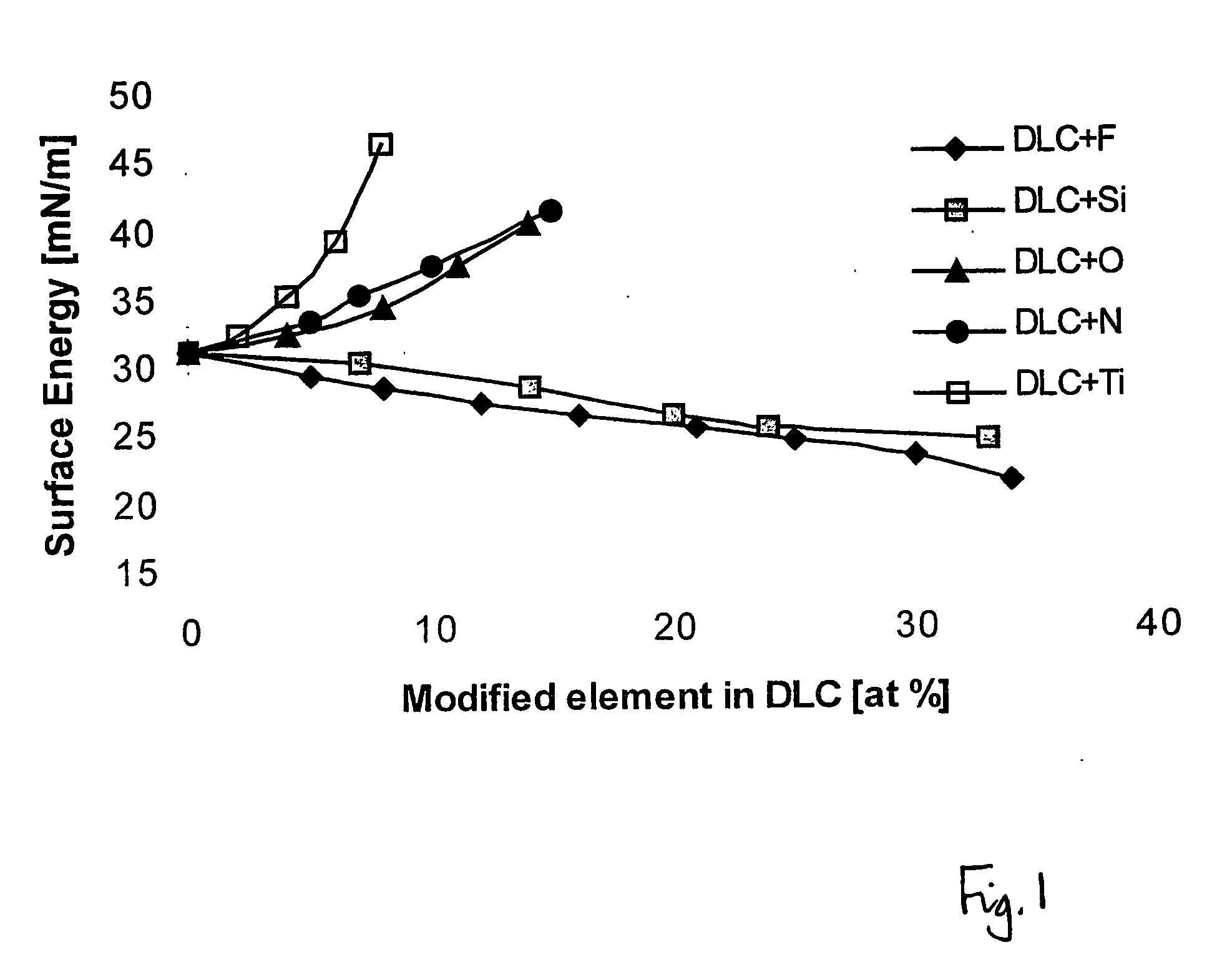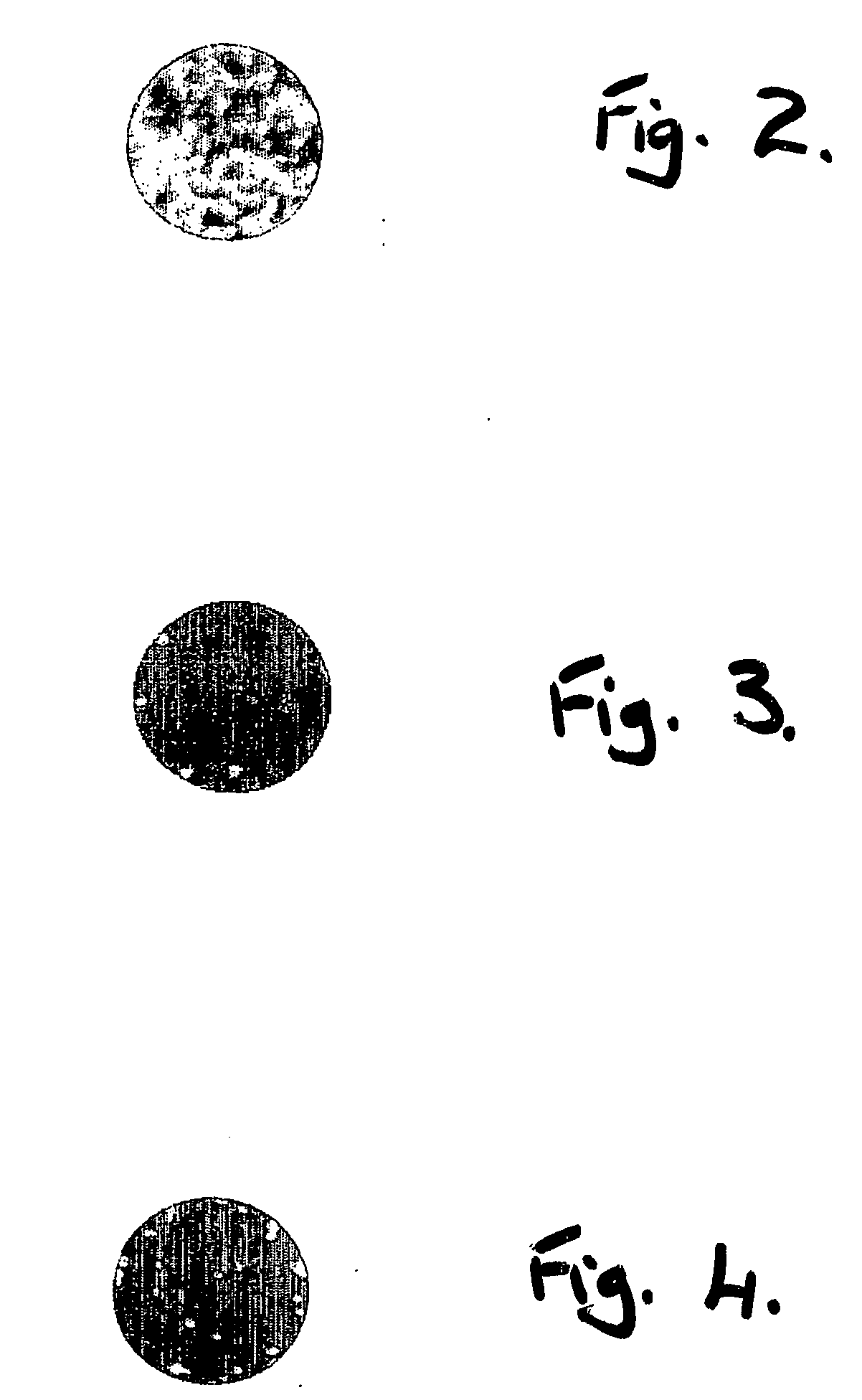Coatings
a technology of coating and surface, applied in the field of coating a surface, can solve the problems of increasing morbidity and mortality, increasing medical costs, and reducing the adhesion or attachment of particles to the modified surface, so as to prevent or minimise the attachment of particles, and reduce the risk of infection.
- Summary
- Abstract
- Description
- Claims
- Application Information
AI Technical Summary
Benefits of technology
Problems solved by technology
Method used
Image
Examples
example 1
[0067]FIG. 3 is a microscope image of the amount of bacteria found on a surface of a medical device with a coating of modified diamond-like carbon which comprises about 4% fluorine. There is a bacteria density of 407 cells / cm2. A combined radio frequency (rf) plasma and magnetron sputtering technique is used to form the coating which is about 2 micrometers thick.
example 2
[0068]FIG. 4 is a microscope image of the amount of bacteria found on a surface of a medical device with a Ag—PTFE-C20H20F23N2O4 surfactant coating of about 4 micrometers thick. The ratio of Ag:PTFE:surfactant is 75%:22%:3% by weight. There is a bacteria density of 614 cells / cm2.
[0069] To form this coating the following electroless plating technique is used:
ProceduresConditions1.Alkaline cleaningNaOH: 20˜30 g / l; Na2CO3: 25˜30g / l; Na3PO4: 25˜35 g / l;Na2SiO3: 5˜10 g / l;Temperature: 60˜80° C., Time:5˜10 min.2.RinsingWith water. Room temperature.3.Cathodic electrocleaningNaOH: 25˜35 g / l; Na2CO3: 25˜30g / l; Na3PO4: 25˜35 g / l;Na2SiO3: 5˜10 g / l; voltage: 5˜7V; Room temperature; Time:2˜3 min.4.RinsingWith water. Room temperature.5.PicklingHCl (30%): H2O = 1:1; Roomtemperature. Time: 0.5˜1 min.6.Activation (to coat aNiCl2.6H2O: 200˜400 g / l; HClsuper-thin layer Ni)(30%): 75˜200 ml / litre;Anode plates: Ni; Cathodiccurrent: 2˜3 A / dm2; Roomtemperature; Time: 1 min.7.Electroless plating Ni—PNiCl2....
example 3
[0070] The following electroless plating technique is used to form a coating of Ni—Cu—P—PTFE nano-composite. The ratio of Ni:Cu:P:PTFE is 80%:11%:4%:5% by weight.
ProceduresConditions1.Alkaline cleaningNaOH: 20˜30 g / l; Na2CO3: 25˜30g / l; Na3PO4: 25˜35 g / l;Na2SiO3: 5˜10 g / l;Temperature: 60˜80° C.,Time: 5˜10 min.2.RinsingWith water. Room temperature.3.Cathodic electrocleaningNaOH: 25˜35 g / l; Na2CO3: 25˜30g / l; Na3PO4: 25˜35 g / l;Na2SiO3: 5˜10 g / l; voltage:5˜7 V; Room temperature;Time: 2˜3 min.4.RinsingWith water. Room temperature.5.PicklingHCl (30%): H2O = 1:1; Roomtemperature. Time: 0.5˜1 min.6.Activation (to coat aNiCl2.6H2O: 200˜400 g / l; HClsuper-thin layer Ni)(30%): 75˜200 ml / litre;Anode plates: Ni; Cathodiccurrent: 2˜3 A / dm2; Roomtemperature; Time: 1 min.7.Electroless plating Ni—PNiCl2.6H2O: 20˜30 g / l;Na3C6H5O7.6H2O: 15˜30 g / l;NaH2PO2: 15˜35 g / l; C3H6O3:20˜30 g / l; Temperature: 85˜90°C.; pH: 4.6˜5.08.RinsingWith water. Room temperature.9.Electroless plating with85˜90° C., pH: 4.8˜5....
PUM
| Property | Measurement | Unit |
|---|---|---|
| pressure | aaaaa | aaaaa |
| temperature | aaaaa | aaaaa |
| thickness | aaaaa | aaaaa |
Abstract
Description
Claims
Application Information
 Login to View More
Login to View More - R&D
- Intellectual Property
- Life Sciences
- Materials
- Tech Scout
- Unparalleled Data Quality
- Higher Quality Content
- 60% Fewer Hallucinations
Browse by: Latest US Patents, China's latest patents, Technical Efficacy Thesaurus, Application Domain, Technology Topic, Popular Technical Reports.
© 2025 PatSnap. All rights reserved.Legal|Privacy policy|Modern Slavery Act Transparency Statement|Sitemap|About US| Contact US: help@patsnap.com


